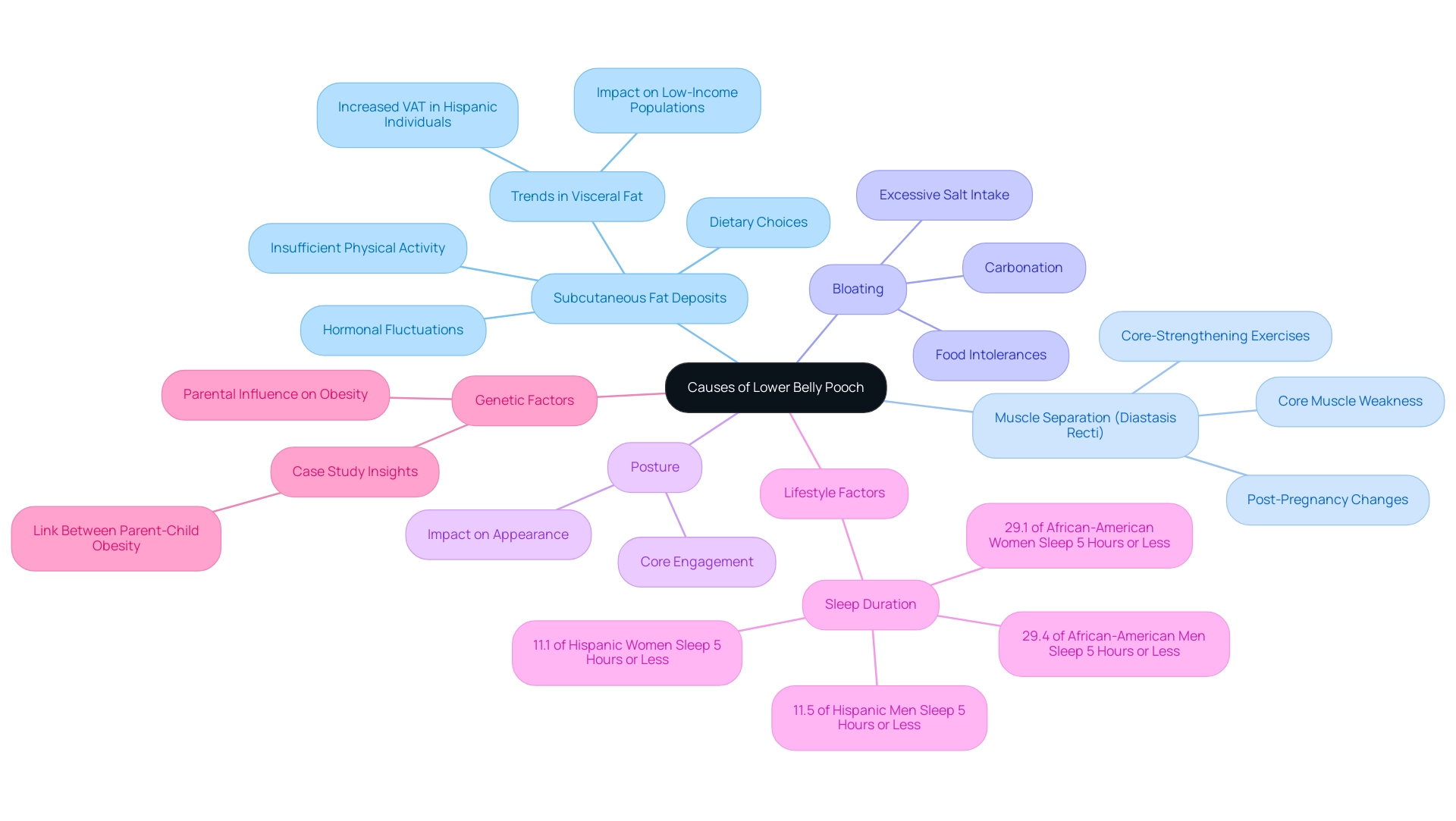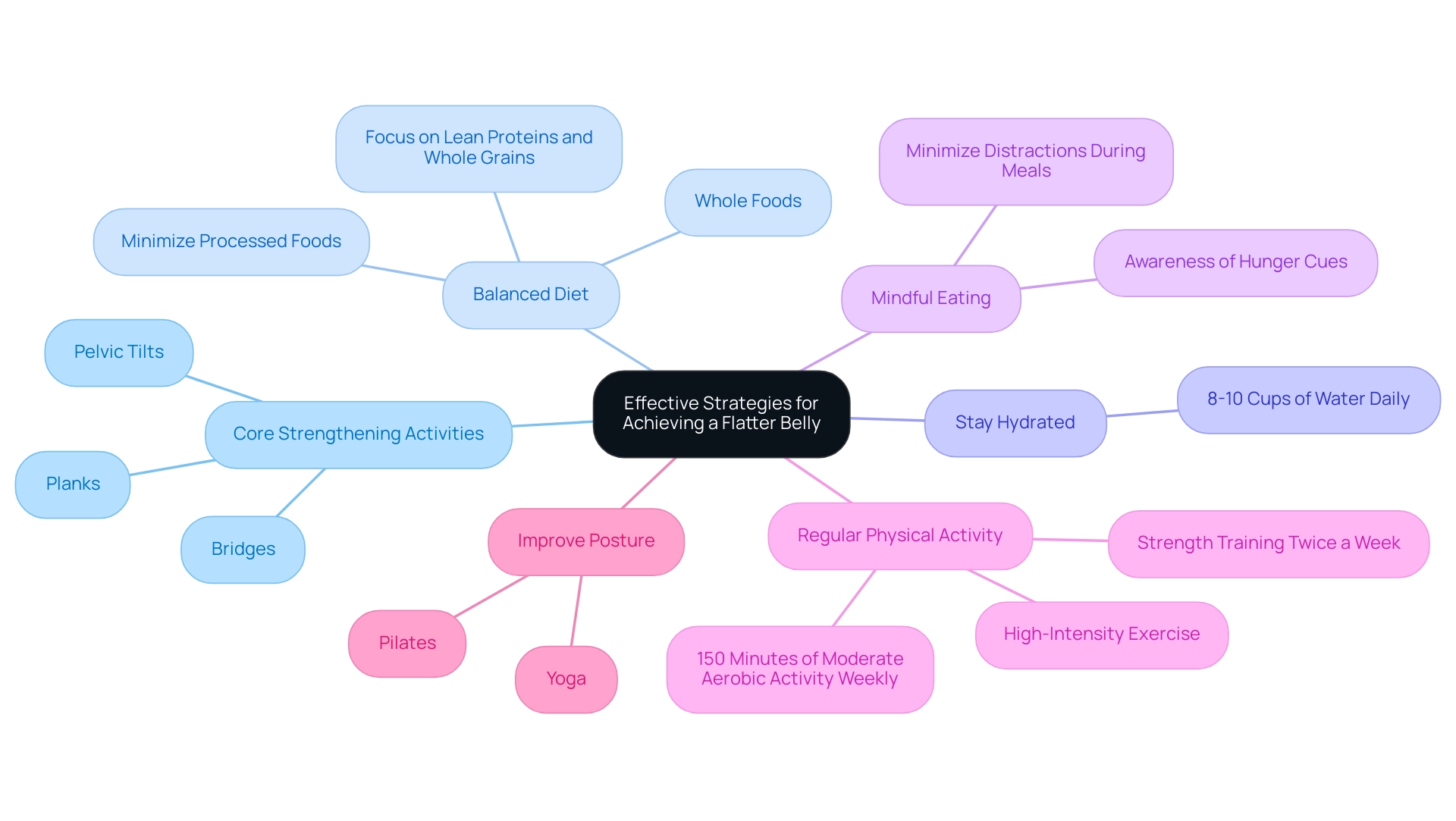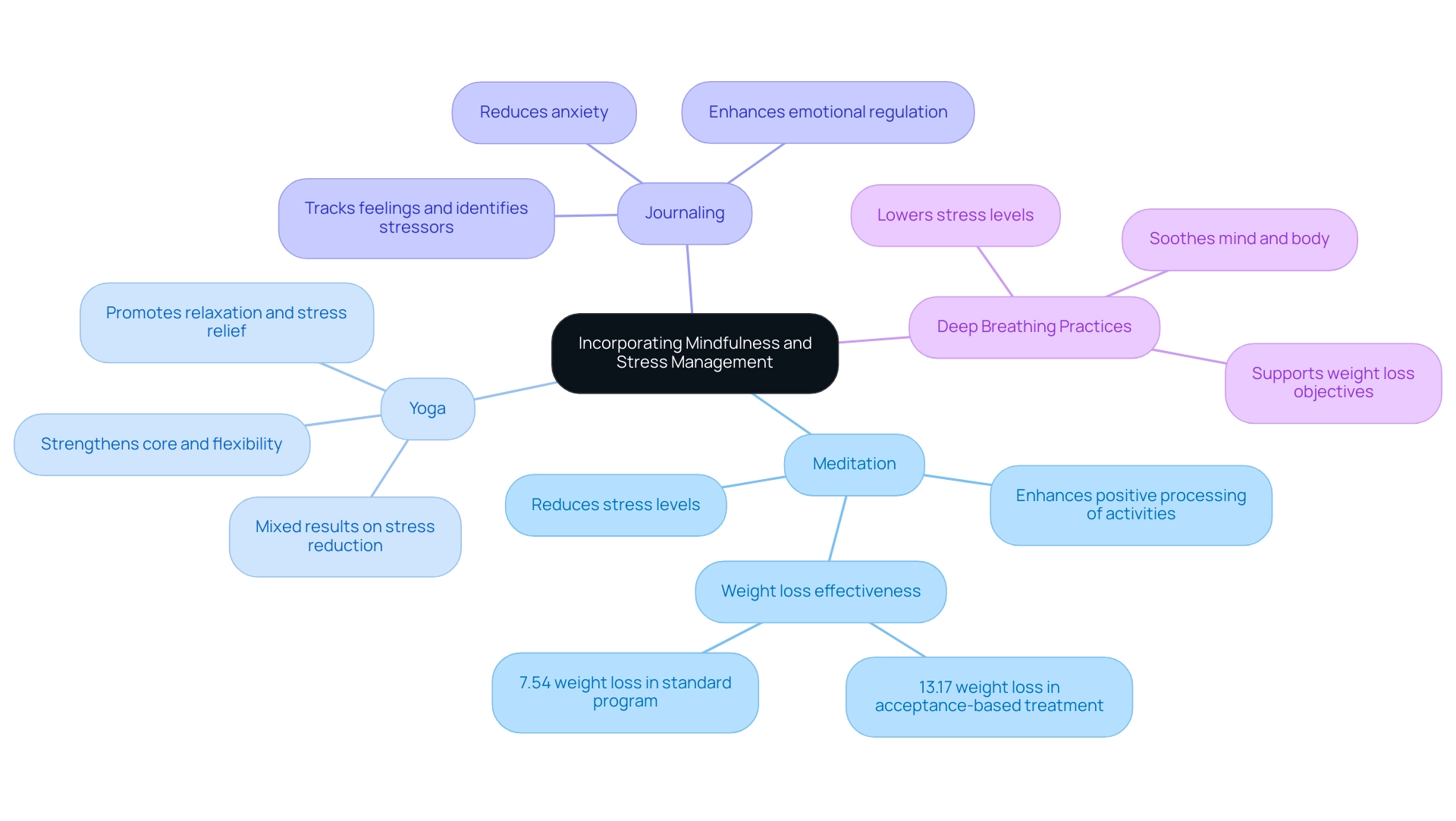Introduction
In a world where health and wellness are paramount, understanding the factors that contribute to the elusive lower belly pooch can empower individuals to take charge of their well-being. This article delves into the multifaceted causes behind this common concern, from lifestyle choices and dietary habits to genetic predispositions.
By recognizing these underlying issues, HR Benefits Managers can create targeted strategies that promote healthier practices within their teams. Furthermore, the journey towards a flatter belly is not solely about physical changes; it encompasses:
- Mindfulness
- Stress management
- The importance of tracking progress
With effective techniques and a supportive environment, achieving wellness goals becomes a rewarding endeavor, fostering a culture of health in the workplace.
Understanding the Causes of the Lower Belly Pooch
The lower belly pooch can be influenced by several factors, each of which presents an opportunity for improvement:
-
Subcutaneous Fat Deposits: This fat resides just below the skin's surface and can accumulate as a result of poor dietary choices, insufficient physical activity, or hormonal fluctuations. Assessing your eating habits and exercise routine is vital for making impactful changes.
Research indicates that trends from 2011 to 2018 showed increases in visceral belly fat percentages, particularly among Hispanic individuals and those below the poverty level, highlighting the importance of addressing these lifestyle factors. These statistics underscore the need for targeted interventions in populations most at risk.
-
Muscle Separation (Diastasis Recti): Often experienced during and after pregnancy, diastasis recti occurs when the core muscles weaken and separate, resulting in a protruding belly.
Understanding this condition is crucial for selecting the right core-strengthening exercises. As stated by Chika V. Anekwe, MD, MPH, an expert in obesity medicine, addressing these physical changes can lead to better outcomes in managing one's body composition.
-
Bloating: Dietary choices play a significant role in bloating, which can be triggered by excessive salt intake, carbonation, or food intolerances.
By identifying and eliminating these dietary culprits, individuals can significantly enhance their abdominal appearance and overall comfort.
-
Posture: Maintaining poor posture can contribute to a protruding belly appearance. Being mindful of your posture throughout the day not only enhances your appearance but strengthens core engagement, which is essential for overall health.
Lifestyle Factors: It's also important to consider broader lifestyle factors that may contribute to abdominal issues. For instance, sleep duration data reveals that 29.4% of African-American men and 29.1% of African-American women sleep 5 hours or less, which can impact overall health and body composition.
Genetic Factors: Additionally, a case study titled 'Your Risk of Having Obesity in Middle Age May Depend on Your Parents' highlights the strong link between parental and child obesity, emphasizing the genetic and familial factors that can influence the causes of lower abdominal pooch. This understanding can assist in customizing interventions that take into account both lifestyle and genetic predispositions.
By acknowledging these underlying causes, HR Benefits Managers can develop a focused action plan to effectively reduce women's pooch while promoting overall wellness within their teams. This understanding is a stepping stone towards fostering a healthier workplace environment.

Effective Strategies for Achieving a Flatter Belly
Achieving a flatter belly involves a combination of strategic lifestyle changes and consistent efforts. At Foresight Health Coaching, we provide tailored programs specifically designed to help individuals and corporate teams succeed in their wellness journeys. Here are key strategies that can lead to success:
-
Include Core Strengthening Activities:
Participate in movements that specifically focus on your core muscles, such as planks, bridges, and pelvic tilts. These movements not only strengthen your core but also help in reducing women's pooch over time. Recent studies, including those by Yoshioka et al., have highlighted the effective role of high-intensity exercises in altering body composition, particularly for those facing metabolic challenges.
Participants in interventions experienced a notable increase in sit and reach distance from 23.48 ± 2.75 cm pre-intervention to 25.96 ± 2.38 cm post-intervention, showcasing the benefits of these exercises.
-
Adopt a Balanced Diet:
Prioritize whole foods like fruits, vegetables, lean proteins, and whole grains while minimizing processed foods and added sugars. A balanced diet is crucial for reducing the women's pooch, as noted by nutrition experts.
Arlene Semeco, a registered dietitian, emphasizes that excess abdominal fat is associated with a higher risk of insulin resistance, type 2 diabetes, and heart disease. This underscores the significance of dietary choices in overall health.
-
Stay Hydrated:
Maintaining adequate hydration is essential. Aim for at least 8–10 cups of water daily to help reduce bloating and support digestion, which can significantly impact your waistline.
-
Practice Mindful Eating:
Being aware of your hunger cues and minimizing distractions during meals can prevent overeating. Mindful eating techniques lead to better digestion and a more satisfying experience.
-
Engage in Regular Physical Activity:
Aim for a minimum of 150 minutes of moderate aerobic activity each week, supplemented by strength training sessions twice a week. This combination not only aids in total-body fat loss but also enhances muscle tone and metabolism. Investigations into high-intensity training (HIET) versus low-intensity training (LIET) for altering body composition in obese women with metabolic syndrome support the effectiveness of HIET, indicating that it may be more beneficial for achieving desired outcomes.
Manage stress, as high levels of stress can lead to weight gain, especially around women's pooch. Incorporating stress-reducing activities such as yoga, meditation, or deep-breathing techniques can be beneficial for both physical and mental health.
-
Improve Posture:
Practicing good posture can naturally engage your core muscles. Consider integrating exercises that promote spinal alignment, such as yoga or Pilates, into your routine.
In addition to these strategies, Foresight Health Coaching offers corporate membership options that include in-person wellness talks and nutrition services, ensuring that teams have access to valuable resources for their health journey. Our unique approach, led by founders with diverse backgrounds in high-performance coaching, allows us to provide a comprehensive hybrid model of service delivery. By consistently applying these strategies and utilizing our personalized coaching and app-based support, you can get closer to attaining a flatter midsection while improving your overall well-being.
Remember that every small step counts, and the journey to better health is a rewarding endeavor.

Incorporating Mindfulness and Stress Management
Incorporating mindfulness and stress management techniques can have a profound impact on your journey towards achieving a flatter belly and addressing women's pooch. Here are some powerful practices that can facilitate this transformation:
-
Meditation: Dedicate 5-10 minutes each day to meditation.
By focusing on your breath and clearing your mind, you can significantly reduce stress levels, which is critical for weight management. Research indicates that mindfulness can enhance the positive processing of physical activity experiences, contributing to overall satisfaction in your wellness journey. A randomized controlled trial showed that the acceptance-based treatment group lost an average of 13.17% of their weight post-treatment, compared to 7.54% in the standard behavioral program, underscoring the effectiveness of mindfulness techniques in weight management.
-
Yoga: Engage in yoga sessions that prioritize core strength and flexibility.
Poses such as the boat pose and bridge not only strengthen the abdominal area but enhance relaxation and stress relief. Recent studies have shown mixed results regarding yoga's impact on stress reduction, yet many practitioners report notable improvements in their mental well-being and physical endurance.
As noted by Tsafou et al., mindfulness may be related to increased satisfaction as it presumably enhances the favorable processing of physical activity experiences.
-
Journaling: Maintaining a journal can be an effective tool for tracking your feelings and identifying stressors.
By writing down your thoughts, you gain clarity and reduce anxiety, which can lead to healthier eating habits. This practice aligns with findings that suggest mindfulness enhances emotional regulation and overall mental clarity, thereby supporting weight management.
-
Deep Breathing Practices: Incorporate deep breathing practices into your daily routine to lower stress levels.
Inhale deeply through your nose, hold for a few seconds, and exhale slowly through your mouth. This technique not only soothes the mind and body but further improves your capacity to handle stress, additionally supporting your weight loss objectives.
By incorporating these mindfulness practices, you can cultivate a healthier relationship with food and exercise, ultimately creating the path for a slimmer waist and reducing a women's pooch. Notably, a case study demonstrated the durability of weight loss after combining mindfulness training with dietary changes, reinforcing the value of a holistic approach in your wellness strategy.

Tracking Progress and Staying Motivated
To fuel your motivation on the journey towards a flatter belly, consider implementing these effective tracking methods:
- Set Realistic Goals: Begin by establishing goals that are specific, measurable, achievable, relevant, and time-bound (SMART). For instance, targeting a specific reduction in waist circumference over a defined time frame not only provides clarity and direction but aligns with findings that the odds of achieving ≥10% weight loss at 12 months are greater for those who set structured goals.
- Keep a Fitness Journal: Documenting your workouts, meals, and emotions offers invaluable insights into your progress. This practice not only assists in recognizing patterns and areas for improvement but highlights your achievements, reinforcing your commitment to your goals. As AA, a consultant at Slimming World, notes, "Tracking your progress can significantly enhance your motivation and accountability."
- Take Progress Photos: Regularly capturing your journey through photographs can serve as a powerful motivator. These visuals provide a tangible representation of your progress, showcasing changes that might not be apparent on a daily basis.
- Celebrate Milestones: Acknowledge and reward yourself for reaching significant milestones. Whether it's treating yourself to a new workout outfit or taking a well-deserved break, celebrating these achievements can enhance your motivation.
- Join a Support Group: Connecting with others on similar journeys—whether in-person or online—can create a sense of community. Sharing experiences, challenges, and successes fosters encouragement and accountability, making the journey feel less isolating. A recent case study demonstrated that extending follow-up periods to 8 weeks with reminders sent to participants significantly improved engagement and adherence to tracking methods.
By actively tracking your progress and celebrating your achievements, you not only sustain motivation but also deepen your commitment to achieving a flatter belly. Remember, the odds of reaching your weight loss goals significantly increase with a structured approach, enabling you to transform your aspirations into reality.
![]()
Conclusion
Recognizing the multifaceted causes of the lower belly pooch is essential for fostering a healthier workplace environment. Factors such as:
- Subcutaneous fat deposits
- Abdominal muscle separation
- Bloating
- Poor posture
- Lifestyle choices
- Genetic predispositions
all play a role in this common concern. By understanding these underlying issues, HR Benefits Managers can develop targeted strategies that address both the physical and emotional aspects of wellness.
Implementing effective strategies, such as:
- Core strengthening exercises
- Balanced nutrition
- Hydration
- Stress management techniques
can significantly contribute to achieving a flatter belly. Incorporating mindfulness practices like meditation, yoga, and journaling can further enhance the journey, promoting a holistic approach to health that resonates with team members. Tracking progress through methods like setting realistic goals and celebrating milestones encourages accountability and motivation, making the path to wellness both engaging and rewarding.
Ultimately, the journey toward a flatter belly is not just about physical changes; it embodies a commitment to overall well-being. By prioritizing health initiatives and creating a supportive environment, HR Benefits Managers can empower their teams to embrace healthier habits, fostering a culture of wellness that benefits everyone. Now is the time to take action, inspire change, and cultivate a thriving workplace where health is at the forefront of every individual’s journey.
Frequently Asked Questions
What are the main factors influencing the lower belly pooch?
The lower belly pooch can be influenced by subcutaneous fat deposits, muscle separation (diastasis recti), bloating, poor posture, lifestyle factors, and genetic factors.
How do subcutaneous fat deposits contribute to the lower belly pooch?
Subcutaneous fat, which lies just below the skin's surface, can accumulate due to poor dietary choices, lack of physical activity, or hormonal fluctuations. Assessing and improving eating habits and exercise routines are essential for making changes.
What is diastasis recti and how does it affect the lower belly pooch?
Diastasis recti is a condition where the core muscles weaken and separate, often occurring during and after pregnancy, leading to a protruding belly. Understanding this condition is important for choosing effective core-strengthening exercises.
What role does bloating play in the appearance of the lower belly pooch?
Bloating can significantly affect the appearance of the abdomen and is often triggered by dietary choices such as excessive salt intake, carbonation, or food intolerances. Identifying and eliminating these triggers can improve comfort and appearance.
How does posture influence the appearance of the lower belly?
Poor posture can contribute to a protruding belly appearance. Being mindful of posture can enhance appearance and strengthen core engagement, which is important for overall health.
What lifestyle factors should be considered regarding the lower belly pooch?
Broader lifestyle factors, such as sleep duration, can impact overall health and body composition. For example, a significant percentage of African-American men and women sleep 5 hours or less, which can affect abdominal issues.
How do genetic factors influence the lower belly pooch?
Genetic factors play a role in obesity and can influence the causes of a lower abdominal pooch. Studies indicate a strong link between parental and child obesity, highlighting the importance of considering genetic predispositions in interventions.
How can HR Benefits Managers use this information to promote wellness?
By understanding the underlying causes of the lower belly pooch, HR Benefits Managers can develop focused action plans to reduce this issue among women while promoting overall wellness within their teams.

